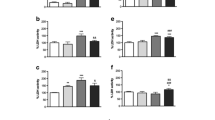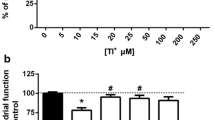Abstract
Incubations of rat striatal slices have been used to assay MPP+ neurotoxicity. MPP+, at concentrations of 1 mM or higher, caused a marked increase in hydroxyl radicals, measured as malondialdehyde (MDA) accumulation, but not in nitric oxide production. At these doses, MPP+ showed an effect on dopamine terminals, causing a massive dopamine decrease, and on non-neuronal glial cells, where a marked reduction in glutamine synthetase activity was detected. At lower concentrations (25 μM), the toxic effect on dopaminergic endings was maintained without increasing malondialdehyde concentrations or inhibiting glutamine synthetase activity. The effect on glutamine synthetase was prevented by the addition to the medium of 0.5% dimethyl sulfoxide, a hydroxyl-radical scavenger, but this did not protect the effect of dopamine depletion. We propose that non-selective effects of MPP+, at doses of 1 mM or higher, are mediated by extracellular overproduction of hydroxyl radicals. The main factor responsible for this overproduction would not be the released dopamine but rather the MPP+ itself, through non selective inhibition of the mitochondrial respiratory chain or through a redox cycling that can trigger oxygen radical production.
Similar content being viewed by others
References
Singer, T. P., and Ramsay, R. R. 1990. Mechanism of the neurotoxicity of MPTP. FEBS Lett. 274:1–8.
Javitch, J. A., and Snyder, S. H. 1985. Uptake of MPP+ by dopamine neurons explains selectivity of parkinsonism-inducing neurotoxin MPTP. Eur. J. Pharmacol. 106:455–456.
Del Zompo, M., Piccardi, M. P., Ruiu, S., Quartu, M., Gessa, G. L., and Vaccari, A. 1993. Selective MPP+ uptake into synaptic dopamine vesicles: possible involvement in MPTP neurotoxicity. Br. J. Pharmacol. 109:411–414.
Espino, A., Llorens, J., Calopa, M., Bartrons, R., Rodríguez-Farré, E., and Ambrosio, S. 1995. Cerebrospinal dopamine metabolites in rats after intrastriatal administration of 6-hydroxydopamine or 1-methyl-4-phenylpyridinium ion. Brain Res. 669:19–25.
Espino, A., Tortosa, A., Bendahan, G., Bartrons, R., Calopa, M., Ferrer, I., and Ambrosio, S. 1994. Stereotaxic administration of 1-methyl-4-phenylpyridinium ion (MPP+) decreases striatal fructose 2,6-bisphosphate in rats. J. Neurochem. 62:1913–1920.
Gibb, W. R. G., Costall, B., Domeney, A. M., Kelly, M. E., and Naylor, R. J. 1988. The histological effects of intracerebral injection or infusion of MPTP and MPP+ in rat and mouse. Brain Res. 461:361–366.
Poirer, J., and Barbeau, A. 1985. A catalyst function for MPTP in superoxide formation. Biochem. Biophys. Res. Commun. 131: 1284–1289.
Adams, J. D., Klaidman, L. K., and Cadenas, E. 1992. MPP+ redox cycling: a new mechanism involving hydride transfer. Pages 239–240.in Langston, W., and Young, A. (eds) Neurotoxins and neurodegenerative disease. Annals New York Academy of Sciences, New York.
Adams, J. D., Klaidman, L. K., and Leung, A. C. 1993. MPP+ and MPDP+ induced oxygen radical formation with mitochondrial enzymes. Free Rad. Biol. Med. 15:181–186.
Di Monte, D., Standy, M. S., Ekström, G., and Smith, M. T. 1986. Comparative studies on the mechanisms of paraquat and 1-methyl-4-phenylpyridine (MPP+ cytotoxicity. Biochem. Biophys. Res. Commun. 137:303–309.
Chiueh, C. C., Krishna, G., Tulsi, P., Obata, T., Lang, K., Huang, S-J., and Murphy, D. L. 1992. Intracranial microdialysis of salicylic acid to detect hydroxyl radical generation through dopamine autooxidation in the caudate nucleus: effects of MPP+. Free Rad. Biol. Med. 13:581–583.
Coyle, J. T., and Puttfarcken, P. 1993. Oxidative stress, glutamate, and neurodegenerative disorders. Science 262:689–695.
Vyas, I., Heikkila, R. E., and Nicklas, W. J. 1986. Studies on the neurotoxicity of 1-methyl-4-phenyl-1,2,3,6-tetrahydropyridine: inhibition of NAD-linked substrate oxidation by its metabolite, 1-methyl-4-phenylpyridinium. J. Neurochem. 46:1501–1507.
Bradford, M. M. 1976. A rapid and sensitive method for the quantitation of microgram quantities of protein utilizing the principle of protein-dye binding. Anal. Biochem. 76:248–254.
Hortelano S., Genaro, A. M., and Boscá, L. 1993. Phorbol esters induce nitric oxide synthase and increase arginine influx in cultured peritoneal macrophages. FEBS Lett. 320:135–139.
Ambrosio, S., Gerli, P., Perego, C., and Algeri, S. 1987. Different toxicity of N-methyl-4-phenyl-1,2,3,5-tetrahydropyridine (MPTP) on the nigrostriatal and mesolimbic pathways. Eur. J. Pharmacol. 133:239–241.
Meister, A. 1985. Glutamine synthetase from mammalian tissues. Pages 185–199,in Meister, A. (eds.) Methods in Enzymology 113. Acad. Press, New York.
Farias, L. A., Smith, E. E., and Markov, A. K. 1990. Prevention of ischemic-hypoxic brain injury and death in rabbits with fructose-1,6-bisphosphate. Stroke 21:606–613.
Tansey, F. A., Farooq, M., and Cammer, W. 1991. Glutamine synthetase in oligodendrocytes and astrocytes: new biochemical and immunocytochemical evidence. J. Neurochem. 56:266–272.
Singer, T. P., Salach, J. I., and Crabtree, D. 1985. Reversible inhibition and mechanism-based irreversible inactivation of monoamine oxidases by 1-methyl-4-phenyl-1,2,3,6-tetrahydropyridine (MPTP). Biochem. Biophys. Res. Commun. 127:707–712.
Dexter, D. T., Carter, C. J., Wells, F. R., Javoy-Agid, F., Agid, Y., Lees, A., Jenner, P., and Marsden, C. D. 1989. Basal lipid peroxidation in substantia nigra is increased in Parkinson’s disease. J. Neurochem. 52:381–389.
Rossetti, Z. L., Sotgiu, A., Sharp, D. E., Hadjiconstantinou, M., and Neff, N. H. 1988. 1-Methyl-4-phenyl-1,2,3,6-tetrahydropyridine (MPTP) and free radicals in vitro. Biochem. Pharmacol. 37: 4573–4574.
Rollema, H., de Vries, J. B., Damsma, G., Westerink, B. H. C., Kranenborg, G. L., Kuhr, W. G., and Horn, A. S. 1988. The use of in vivo brain dialysis of dopamine, acetylcholine, aminoacids and lactic acid in studies on the neurotoxin 1-methyl-4-phenyl-1,2,3,6-tetrahydropyridine (MPTP). Toxicology 49:503–511.
Symons, A. M., Dowling, E. J., and Parke, D. V. 1988. Lipid peroxidation, free radicals and experimental inflammation. Pages 987–990,in Simic M. G., Taylor, K. A., Ward, J. F., and von Sonntag, C. (eds) Oxygen Radicals in Biology and Medicine. Plenum Press, New York.
Santiago, M., Machado A., and Cano, J. 1994. Effect of 1-arginine/nitric oxide pathway on MPP+-induced cell injury in the striatum of rats. Br. J. Pharmacol. 111:837–842.
Schülz, J. B., Matthews, R. T., Muqit, M. M. K., Browne, S. E., and Beal, M. F. 1995. Inhibition of neuronal nitric oxide synthase by 7-nitroindazole protects against MPTP-induced neurotoxicity in mice. J. Neurochem. 64:936–939.
Bump, E. A., Pierce, S. M., Obcemea, C. H., Chin, L., and Coleman, N. 1988. Effect of OH scavenging on the yield of radiation-induced DNA double-strand breaks in isolated nuclei. Pages 429–432,in Simic, M. G., Taylor, K. A., Ward, J. F., and von Sonntag, C. (eds.) Oxygen Radicals in Biology and Medicine, Plenum Press, New York.
Martinovits, G., Melamed, E., Cohen, O., Rosenthal, J., and Uzzan, A. 1986. Systemic administration of antioxidants does not protect mice against the dopaminergic neurotoxicity of 1-methyl-4-phenyl-1,2,5,6-tetrahydropyridine (MPTP). Neurosci. Lett. 69: 192–197.
Schor, N. F., 1988. Inactivation of mammalian brain glutamine synthetase by oxygen radicals. Brain Res. 456:17–21.
Levine, R. L. 1983. Oxidative modification of glutamine synthetase. J. Biol. Chem. 258:11828–11833.
Hollinden, G. E., Sanchez-Ramos, J. R., Sick, T. J., and Rosenthal, M. 1988. MPP+-induced increases in extracellular potassium ion activity in striatal slices suggest that consequences of MPP+ neurotoxicity are spread beyond dopaminergic terminals. Brain Res. 475:283–290.
Hollinden, G. E., Sanchez-Ramos, J. R., Sick, T. J., and Rosenthal, M. 1989. MPP+-induced pathophysiology demonstrates advantages of neurotoxicology studies in brain slices. J. Neurosci. Meth. 28:51–57.
Ofori, S., Heikkila, R. E., and Nicklas, W. J. 1989. Attenuation by dopamine uptake blockers of the inhibitory effects of 1-methyl-4-phenyl-1,2,3,6-tetrahydropyridine and some of its analogs on NADH-linked metabolism in mouse neostriatal slices. J. Pharmacol. Expt. Ther. 251:258–265.
Author information
Authors and Affiliations
Rights and permissions
About this article
Cite this article
Ambrosio, S., Espino, A., Cutillas, B. et al. MPP+ toxicity in rat striatal slices: Relationship between non-selective effects and free radical production. Neurochem Res 21, 73–78 (1996). https://doi.org/10.1007/BF02527674
Accepted:
Issue Date:
DOI: https://doi.org/10.1007/BF02527674




